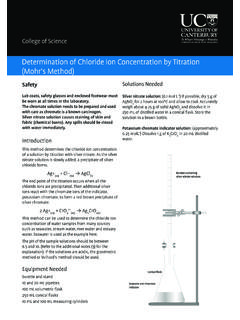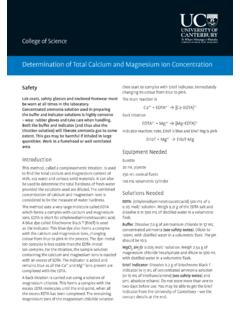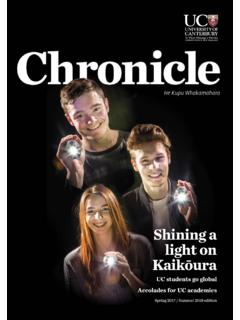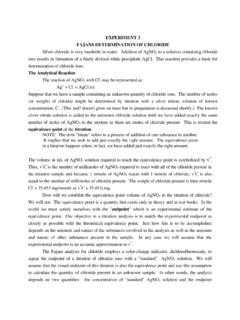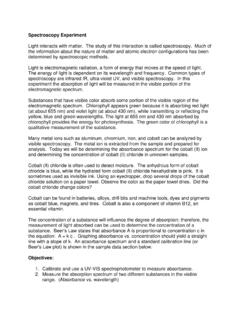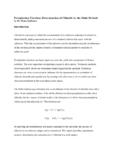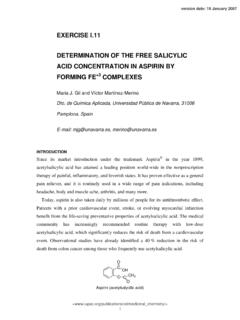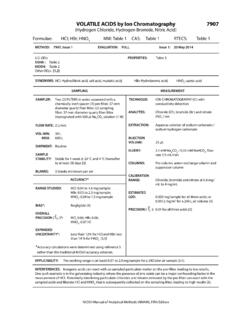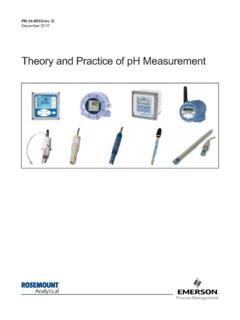Transcription of Determination of Chloride Ion Concentration by Titration ...
1 College of ScienceSafety Lab coats, safety glasses and enclosed footwear must be worn at all times in the laboratory. Silver nitrate solution causes staining of skin and fabric (chemical burns). Any spills should be rinsed with water immediately. Concentrated nitric acid is very corrosive: take great care using the 6molL-1 solution. IntroductionThis method uses a back Titration with potassium thiocyanate to determine the Concentration of Chloride ions in a solution. Before the Titration an excess volume of a silver nitrate solution is added to the solution containing Chloride ions, forming a precipitate of silver Chloride . The term excess is used as the moles of silver nitrate added are known to exceed the moles of sodium Chloride present in the sample so that all the Chloride ions present will +(aq) + Cl (aq) AgCl(s)The indicator Fe3+ (ferric ion) is then added and the solution is titrated with the potassium thiocyanate solution.
2 The titrate remains pale yellow as the excess (unreacted) silver ions react with the thiocyanate ions to form a silver thiocyanate +(aq) + SCN (aq) AgSCN(s)Once all the silver ions have reacted, the slightest excess of thiocyanate reacts with Fe3+ to form a dark red +(aq) + SCN (aq) [FeSCN]2+(aq)The Concentration of Chloride ions is determined by subtracting the Titration findings of the moles of silver ions that reacted with the thiocyanate from the total moles of silver nitrate added to the method is used when the pH of the solution, after the sample has been prepared, is acidic. If the pH is neutral or basic, Mohr s method or the gravimetric method should be used. The method is illustrated below by using the procedure to determine the Concentration of Chloride (from sodium Chloride ) in Neededboiling chips500 mL volumetric flask10 mL and 100 mL measuring cylindersconical flasksBunsen burner, tripod and gauzeburette and stand50 mL pipette (if possible) Determination of Chloride Ion Concentration by Titration (Volhard s Method)1 Determination of Chloride Ion Concentration by Titration (Volhard s Method)IntroductionThis method uses a back Titration with potassium thiocyanate to determine the Concentration of Chloride ions in a solution.
3 Before the Titration an excess volume of a silver nitrate solution is added to the solution containing Chloride ions, forming a precipitate of silver Chloride . The term excess is used as the moles of silver nitrate added are known to exceed the moles of sodium Chloride present in the sample so that all the Chloride ions present will react. Ag+(aq) + Cl (aq) AgCl(s)The indicator Fe3+ (ferric ion) is then added and the solution is titrated with the potassium thiocyanate solution. The titrate remains pale yellow as the excess (unreacted) silver ions react with the thiocyanate ions to form a silver thiocyanate +(aq) + SCN (aq) AgSCN(s)Once all the silver ions have reacted, the slightest excess of thiocyanate reacts with Fe3+ to form a dark red +(aq) + SCN (aq) [FeSCN]2+(aq)The Concentration of Chloride ions is determined by subtracting the Titration findings of the moles of silver ions that reacted with the thiocyanate from the total moles of silver nitrate added to the solution.
4 This method is used when the pH of the solution after the sample has been prepared is acidic. If the pH is neutral or basic, Mohr s method or the gravimetric method should be used. The method is illustrated below by using the procedure to determine the Concentration of Chloride (from sodium Chloride ) in Neededboiling chips500 mL volumetric flask10 mL and 100 mL measuring cylindersconical flasksBunsen burner, tripod and gauzeburette and stand50 mL pipette (if possible)Burette containing potassium thiocyanate solutionConical flaskCheese extract solutionSolutions NeededConcentrated nitric acid (see safety notes): (6 mol L-1)Silver nitrate solution: ( mol L 1). If possible, dry 5 g of AgNO3 for 2 hours at 100 C and allow to cool. Accurately weigh about g of solid AgNO3 and dissolve it in 250 mL of distilled water in a conical flask.
5 Store the solution in a brown thiocyanate solution: ( mol L 1). Weigh g of solid KSCN and dissolve it in 250 mL of distilled water in a volumetric permanganate solution: (5%) Add g KMnO4 to 30 mL of distilled ammonium sulfate solution: (saturated) Add 8g of NH4Fe(SO4) to 20 mL of distilled water and add a few drops of concentrated nitric acid (see safety notes).MethodSample PreparationThe salt sodium Chloride is added during the manufacture of cheddar cheese. In this method, the cheese is digested to release this salt to obtain the Concentration of Chloride ions. To carry out this digestion, the cheese is reacted with nitric acid and potassium permanganate. The Chloride ions are then free to form a precipitate with the added silver Cut or grate the cheese into fine pieces and accurately weigh about 6 g into a 500 mL conical Precisely add 50 mL of mol L 1 silver nitrate solution (by pipette if possible), 20 mL of concentrated nitric acid, (very carefully see safety notes), 100 mL of distilled water and a few boiling chips, and heat the solution to boiling in a As the solution boils add 5 mL of 5% potassium permanganate solution.
6 This addition will cause a very smelly reaction so done in the fumehood. Keep boiling until the purple colour disappears, then add another 5 mL of potassium permanganate solution. Continue this process until 30 mL of potassium permanganate solution has been added and the cheese particles are completely digested (or as close as possible). To find out when digestion is complete, remove the flask from heat and allow it to stand for a few moments. Undigested cheese particles will float upon the surface of the clear liquid, while the white precipitate of silver Chloride will sink to the bottom. If there is still too much undigested cheese, the boiling and addition of 5 mL of potassium permanganate should be continued, checking each time until there is a satisfactory level of Cool the solution and filter it. Wash the solid residue with a few mL of distilled Make the filtrate up to 500 mL in a volumetric Use a volumetric cylinder to measure 100 mL of the cheese extract solution (be as precise as possible) and pour it into a conical Add 1 mL of saturated ferric ammonium sulfate solution as Titrate the unreacted silver ions with the mol L 1 potassium thiocyanate solution.
7 The end point is the first appearance of a dark red colour due to the ferric thiocyanate complex (figure 1).4. Repeat the Titration with 100 mL samples of the cheese extract solution until you obtain concordant results (titres agreeing within mL).2 Solutions NeededConcentrated nitric acid (see safety notes): (6 mol L-1)Silver nitrate solution: ( mol L 1). If possible, dry 5 g of AgNO3 for 2 hours at 100 C and allow to cool. Accurately weigh about g of solid AgNO3 and dissolve it in 250 mL of distilled water in a conical flask. Store the solution in a brown bottle. Potassium thiocyanate solution: ( mol L 1). Weigh g of solid KSCN and dissolve it in 250 mL of distilled water in a volumetric permanganate solution: (5%) Add g KMnO4 to 30 mL of distilled ammonium sulfate solution: (saturated) Add 8 g of NH4Fe(SO4) to 20 mL of distilled water and add a few drops of concentrated nitric PreparationThe salt sodium Chloride is added during the manufacture of cheddar cheese.
8 In this method, the cheese is digested to release this salt to obtain the Concentration of Chloride ions. To carry out this digestion, the cheese is reacted with nitric acid and potassium permanganate. The Chloride ions are then free to form a precipitate with the added silver Cut or grate the cheese into fine pieces and accurately weigh about 6 g into a 500 mL conical Precisely add 50 mL of mol L 1 silver nitrate solution (by pipette if possible), 20 mL of concentrated nitric acid, (very carefully see safety notes), 100 mL of distilled water and a few boiling chips, and heat the solution to boiling. 3. As the solution boils add 5 mL of 5% potassium permanganate solution. This addition will cause a very smelly reaction and should be done in a fumehood. Keep boiling until the purple colour disappears, then add another 5 mL of potassium permanganate solution.
9 Continue this process until 30 mL of potassium permanganate solution has been added and the cheese particles are completely digested (or as close as possible). To find out when digestion is complete, remove the flask from heat and allow it to stand for a few moments. Undigested cheese particles will float upon the surface of the clear liquid, while the white precipitate of silver Chloride will sink to the bottom. If there is still too much undigested cheese, the boiling and addition of 5 mL of potassium permanganate should be continued, checking each time until there is a satisfactory level of digestion. 4. Cool the solution and filter it. Wash the solid residue with a few mL of distilled Make the filtrate up to 500 mL in a volumetric Use a volumetric cylinder to measure 100 mL of the cheese extract solution (be as precise as possible) and pour it into a conical flask.
10 2. Add 1 mL of saturated ferric ammonium sulfate solution as Titrate the unreacted silver ions with the mol L 1 potassium thiocyanate solution. The end point is the first appearance of a dark red colour due to the ferric thiocyanate complex (figure 1).4. Repeat the Titration with 100 mL samples of the cheese extract solution until you obtain concordant results (titres agreeing within mL).Figure 1 Left flask: before the Titration endpoint, addition of SCN ions leads to formation of silver thiocyanate precipitate, making the solution cloudy. Here the solution also takes a faint yellow colour due to the colour of the cheese extract. Centre flask: at the endpoint all the free silver ions have been precipitated by SCN . The slightest excess of SCN forms a dark red coloured complex with the Fe3+ ions from the ferric ammonium sulfate indicator, giving the solution a slight orange/red colouration.

